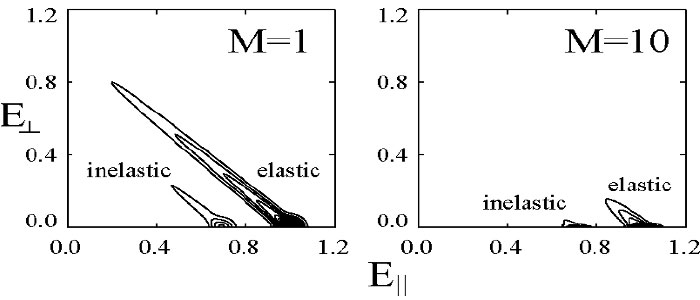Scattering positrons
Scattering Studies
Numerous aspects of positron interactions with atoms and molecules can be investigated using scattering techniques. The buffer-gas-trap-based, high-energy-resolution positron beam has enabled new capabilities. Since the beam is magnetically guided, new techniques were developed to carry out these measurements. Key results include the first measurements of state-resolved cross sections for electronic (atoms and molecules) and vibrational excitation (molecules) and refined measurements of positron-impact cross sections for elastic scattering, direct ionization and positronium formation.
The scattering technique involves passing the beam through a cell containing the test gas, then passing the transmitted beam (containing un-scattered and scattered particles) thorough a retarding potential analyzer (RPA). The adiabatic invariance of E⊥/B (i.e., energy tied up in cyclotron motion/magnetic field strength) can be used to measure elastic scattering if B is held constant along the beam path (M = 1 case above, where M is the ratio of B at the RPA relative to that in the scattering cell). If B is greatly reduced at the RPA relative to that at the scattering cell (e.g., M = 10 case above), then the RPA measures the total energy loss, enabling measurement of cross sections for inelastic processes [1, 2].
Highlights include the cross section for electronic excitation and Ps formation in N2 (right, above) [3], the key to BGT efficiency; and excitation of the asymmetric C-F stretch mode in CF4 (right, below), which enables rapid cooling in the BGT [4]. State-resolved study of molecular rotational excitations will be possible using the new CBT-based beam LINK.
Further Reading:
Low-energy positron interactions with atoms and molecules, C. M. Surko, G. F. Gribakin, and S. J. Buckman, J. Phys. B, 38, R57 (2004).
Positron Scattering from Atoms and Molecules at Low Energies, S. J. Gilbert, R.G. Greaves, and C. M. Surko, Phys. Rev. Lett., 82, pp. 5032-35 (1999).
Positron Scattering from Atoms and Molecules Using a Magnetized Beam, J. P. Sullivan, S. J. Gilbert, J. P. Marler, R. G. Greaves, S. J. Buckman, and C. M. Surko, Phys. Rev. A 66, 042708, pp. 1-12 (2002)
Excitation of molecular vibrations by positron impact, J. P. Sullivan, S. J. Gilbert and C. M. Surko, Phys. Rev. Lett., 86, pp. 1494-97 (2001).
Excitation of Electronic States of Ar, H2, and N2 by Positron Impact, J. P. Sullivan, J. P. Marler, S. J. Gilbert, S. J. Buckman, and C. M. Surko, Phys. Rev. Lett., 87, 073201, pp. 1-4 (2001).
Ionization and Positronium Formation in Noble Gases, J. P. Marler, J. P. Sullivan, and C. M. Surko, Phys. Rev. A 71, pp. 022701-12 (2005).
Systematic Comparison of Positron and Electron Impact Ionization of the n3 vibrational mode of CF4, J. P. Marler and C. M. Surko, Phys. Rev. A 72, 062702 (2005).
Positron-impact Ionization, Positronium Formation and Electronic Excitation Cross Sections for Diatomic Molecules, J. P. Marler and C. M. Surko, Phys. Rev. A 72, 062713 (2005).
Comparison of Positron-impact Vibrational Excitation Cross Sections with the Born-dipole Model, J. P. Marler, G. F. Gribakin, and C. M. Surko, Nucl. Instrum. and Meth. B 247, pp. 87–91 (2006).

